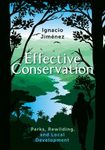About this book
While restoration ecology has traditionally aimed to re-create some putative more 'natural' ecological state, forest landscape restoration (FLR) has emerged over the last decade as an approach aimed more at restoring natural functions, while focusing on meeting human needs.
With a view to exploring the practical potential of this approach, A Goal-Oriented Approach to Forest Landscape Restoration draws together a team of experts from the natural and social sciences to discuss its success so far in addressing critical issues such as biodiversity, ecological function, and human livelihoods. Applying principles of landscape ecology, restoration ecology, planning theory and conflict management, the book presents a series of case studies which document the approach, and discusses how the approach can help with priority setting for the future.
A Goal-Oriented Approach to Forest Landscape Restoration will provide a valuable reference to graduate students and researchers interested in ecological restoration, forest ecology and management, as well as to professionals in environmental restoration, natural resource management, conservation, and environmental policy.
Contents
I. Setting Goals
1. A Tool for Comparing Alternative Forest Landscape Restoration Scenarios; David Pullar and David Lamb, University of Queensland, Brisbane, Australia
2. Forest Landscape Restoration in the Netherlands: Policy Aspects and Knowledge Management; Rob J.J. Hendriks, Ministry of Agriculture, Nature and Food Quality, Ede; René G.A. Boot, Tropenbos International, Wageningen; Wim de Haas and Herman J.F. Savenije, Ministry of Agriculture, Nature and Food Quality, Ede, The Netherlands
3. Incorporating Social and Natural Science in the Restoration of an Indonesian Conservation Forest: A Case Study from Jambi; Ulfah J. Siregar, Iskandar Z. Siregar, S. Wilarso Budi, Y. Hero, D. Suharjito, and Hardjanto, Bogor Agricultural University, Indonesia
II. Restoring Biodiversity
4. Forest Landscape Restoration in China, Weimin Xi, University of Wisconsin-Madison, Madison, Wisconsin, USA; Huaxing Bi, Beijing Forestry University, Beijing; and Binghui He, Southwest University, Chongqing, China
5. Managing Forest Stand Structures to Enhance Conservation of the Amur Tiger (Panthera tigris altaica); Xuemei Han and Chadwick Dearing Oliver, Yale University, New Haven, Connecticut, USA; Jianping Ge, Beijing Normal University, Beijing; Qingxi Guo, China Northeastern Forestry University, Harbin; and Xiaojun Kou, Beijing Normal University, Beijing, China
6. Restoration of Forests Associated with New Town Development in Hong Kong; C.Y. Jim ,The University of Hong Kong, China
7. Integrating Scientific Research with Community Needs to Restore Forest Landscapes in Northern Thailand: A Case Study of Ban Mae Sa Mai; Stephen Elliot, Cherdsak Kuaraksa, Panitnard Tunjai, Tiderach Toktang, Kunakorn Boonsai, Sudarat Sangkum, Sutthathorn Suwanaratanna and David Blakesley, Chiang Mai University, Chiang Mai, Thailand
8. Non-native Plants and Adaptive Collaborative Approaches to Ecosystem Restoration in the United States; John Schelhas, US Forest Service, Athens, Georgia; James H. Miller, US Forest Service, Auburn, Alabama; and Jeanne Chambers, US Forest Service, Ft. Collins, Colorado, USA
9. Restoring Fire-Adapted Forests in Eastern North America For Biodiversity Conservation and Hazardous Fuels Reduction; Ross J. Phillips, Thomas A. Waldrop, US Forest Service, Clemson South Carolina; Patrick H. Brose, US Forest Service, Irvine, Pennsylvania; and Geoff G. Wang, Clemson University, Clemson, South Carolina, USA
10. Forest Landscape Restoration: Linkages with Stream Fishes of the Southern United States; Melvin L. Warren, Jr., US Forest Service, Oxford, Mississippi, USA
III. Restoring Ecological Functioning and Livelihoods
11. Restoration of Deforested and Degraded Areas in Africa; Dominic Blay, Forest Research Institute of Ghana, Kumasi, Ghana
12. Restoration of Southern Pine Forests after the Southern Pine Beetle; Weimin Xi, Texas A&M University, College Station, Texas; John D. Waldron, University of West Florida, Ft. Walton Beach, Florida; David M. Cairns, Charles W. Lafon, Andrew G. Birt, Maria D. Tchakerian, Texas A&M University, College Station, Texas; Kier D. Klepzig, US Forest Service, Asheville, North Carolina; and Robert N. Coulson, Texas A&M University, College Station, Texas, USA
13. Forest Landscape Restoration in Australia’s Murray-Darling Basin; Trevor H. Booth, CSIRO Climate Adaptation Flagship, Canberra, ACT, Australia
14. Restoring Broadleaved Forests in Southern Sweden as Climate Changes; Magnus Löf and J. Brunet, Swedish University of Agricultural Sciences, Alnarp; T. Hickler, Lund University, Lund; Maria Birkedal and Anna Jensen, Swedish University of Agricultural Sciences, Alnarp, Sweden
15. Restoring Floodplain Forests in Europe; Francine Hughes, Anglia Ruskin University, Cambridge, UK; Marta Gonzáles del Tánago, Universidad Politéchnicia de Madrid, Madrid, Spain; J. Owen Mountford, NERC-Centre for Ecology and Hydrology, Wallingford, UK
16. Restoration of Freshwater Cypress-Tupelo Wetlands in the Southeastern US Following Severe Hurricanes; William H. Conner, Clemson University, South Carolina; Ken W. Krauss, US Geological Survey, Lafayette, Louisiana; Gary P. Shaffer, Southeastern Louisiana University, Hammond, Louisiana, USA
17. Planted Forests and Trees Can Restore Landscapes and Alleviate Poverty; Linda Rosengren, Food and Agricultural Organization of the United Nations (FAO), Rome, Italy
Customer Reviews
















































